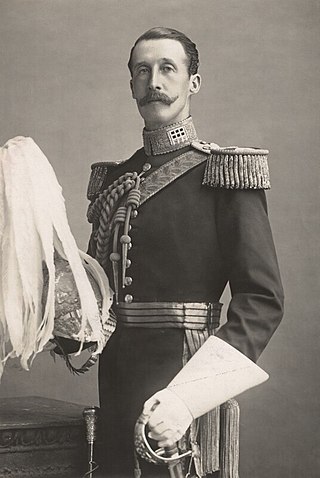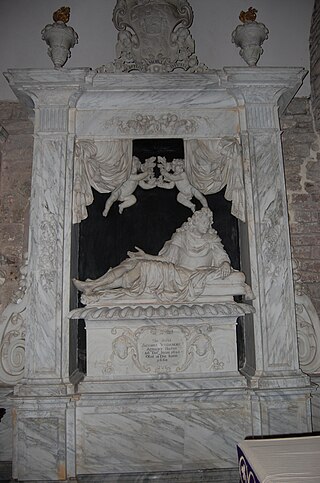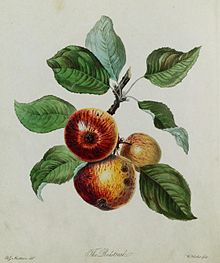Perry is an alcoholic beverage made from fermented pears, traditionally in England, particularly Gloucestershire, Herefordshire, and Worcestershire, parts of South Wales and France, especially Normandy and Anjou, Canada, Australia and New Zealand.

Cider apples are a group of apple cultivars grown for their use in the production of cider. Cider apples are distinguished from "cookers" and "eaters", or dessert apples, by their bitterness or dryness of flavour, qualities which make the fruit unpalatable but can be useful in cidermaking. Some apples are considered to occupy more than one category.

Viscount Scudamore was a title in the Peerage of Ireland held by three generations of the Scudamore family. It was created on 1 July 1628 for the diplomat and politician Sir John Scudamore, 1st Baronet. He had already been created a Baronet, of Holme Lacy in the County of Hereford, in the Baronetage of England on 1 June 1620, and was made Baron Dromore at the same time as he was granted the viscountcy, also in the Peerage of Ireland. Scudamore was the son of Sir James Scudamore and the grandson of Sir John Scudamore. Lord Scudamore was succeeded by his grandson, the second Viscount. He represented Hereford and Herefordshire in Parliament. On his death the titles passed to his son, the third Viscount. He was also Member of Parliament for Hereford and Herefordshire. The titles became extinct on his death in 1716.

Edwyn Francis Scudamore-Stanhope, 10th Earl of Chesterfield,, styled Lord Stanhope between 1883 and 1887, was a British peer and courtier.
Holme Lacy is a village in the English county of Herefordshire. The population of the civil parish was 466 at the 2011 Census.

The Kingston Black, also known as Black Taunton, is a cultivar of apple originating from the United Kingdom and used in making cider. The name of the cultivar comes from the apples' dark red or purplish skin, though despite the name, the fruit does not have a black hue.

Sir James Scudamore was a gentleman usher at the court of Queen Elizabeth I. Born at Holme Lacy, Herefordshire, he was the eldest son of John Scudamore, Custos Rotulorum of Herefordshire and his first wife Eleanor Croft, daughter of former Lord Deputy of Ireland James Croft. He would assume that title in 1616, and remained Custos Rotulorum for two years until his own death in 1619. Scudamore was respected for his tilting skill and his embodiment of the ideals of chivalry.
'Brown Snout' is a 19th-century cultivar of cider apple originating in Herefordshire in the United Kingdom, though now grown in other counties and parts of the world.

The Foxwhelp is a very old cider apple cultivar, originating in the west Midlands of England.

The Styre or Stire, also known as the Forest Styre, was an old English variety of cider apple which was formerly common in the Forest of Dean. It is currently thought to be extinct, but may still survive in old orchards or gardens.

James Scudamore was an English politician who sat in the House of Commons at various times between 1642 and 1668.

St Cuthbert's Church is a redundant Anglican church about 1 mile (1.6 km) to the southeast of the village of Holme Lacy, Herefordshire, England. It stands in an isolated position at the end of a lane in a bend of the River Wye. It is designated in the National Heritage List for England as a Grade I listed building, and is under the care of the Churches Conservation Trust.
Cider in the United Kingdom is widely available at pubs, off licences, and shops. It has been made in regions of the country where cider apples were grown since Roman times; in those regions it is intertwined with local culture.

'Tom Putt' is a traditional variety of dual purpose apple, often used as a cider apple, originating in Devon. It was also known as Ploughman, Coalbrook, Marrowbone, Thomas Jeffreys and by many other local names.

The Woodcock was one of the oldest described English varieties of cider apple. It originated in the West of England in the counties of Herefordshire and Gloucestershire.
The 'Chisel Jersey' is a cultivar of cider apple originating in Somerset.
Michelin is a variety of cider apple commonly grown in commercial orchards in the United Kingdom, although originating in France.
The Coccagee, also spelt 'Cackagee' or 'Cockagee' and sometimes known as the 'Irish Crab' or 'Lord Cork's Crab', is or was a variety of cider apple, known in Ireland and the West of England.
Major is a cider apple cultivar first grown in the United Kingdom in the area of Devon and Somerset.
The Scudamorefamily is an English noble family. The family settled in Herefordshire at two seats, Holme Lacy and Kentchurch Court, before lines moved to Devon, Somerset and Derbyshire. The family first gained prominence in the 15th and 16th centuries, before becoming ennobled as Viscount Scudamore and Baron Dromore in the 17th century, and were granted two baronetcies in 1620 and 1644. The family married into several noble dynasties including the Cecil, Beaufort, and Howard families, and became ancestors to the Earls of Chesterfield.










